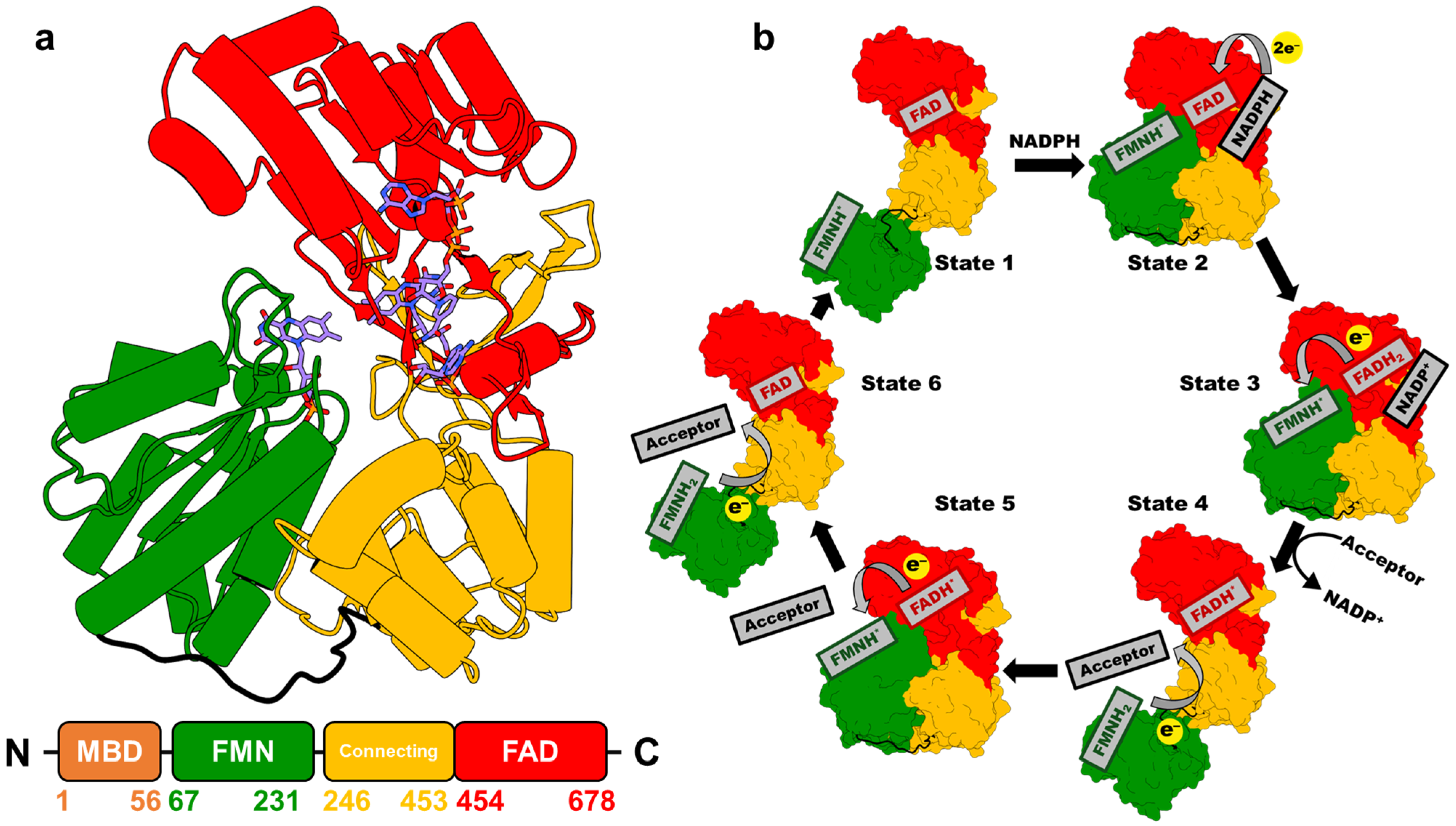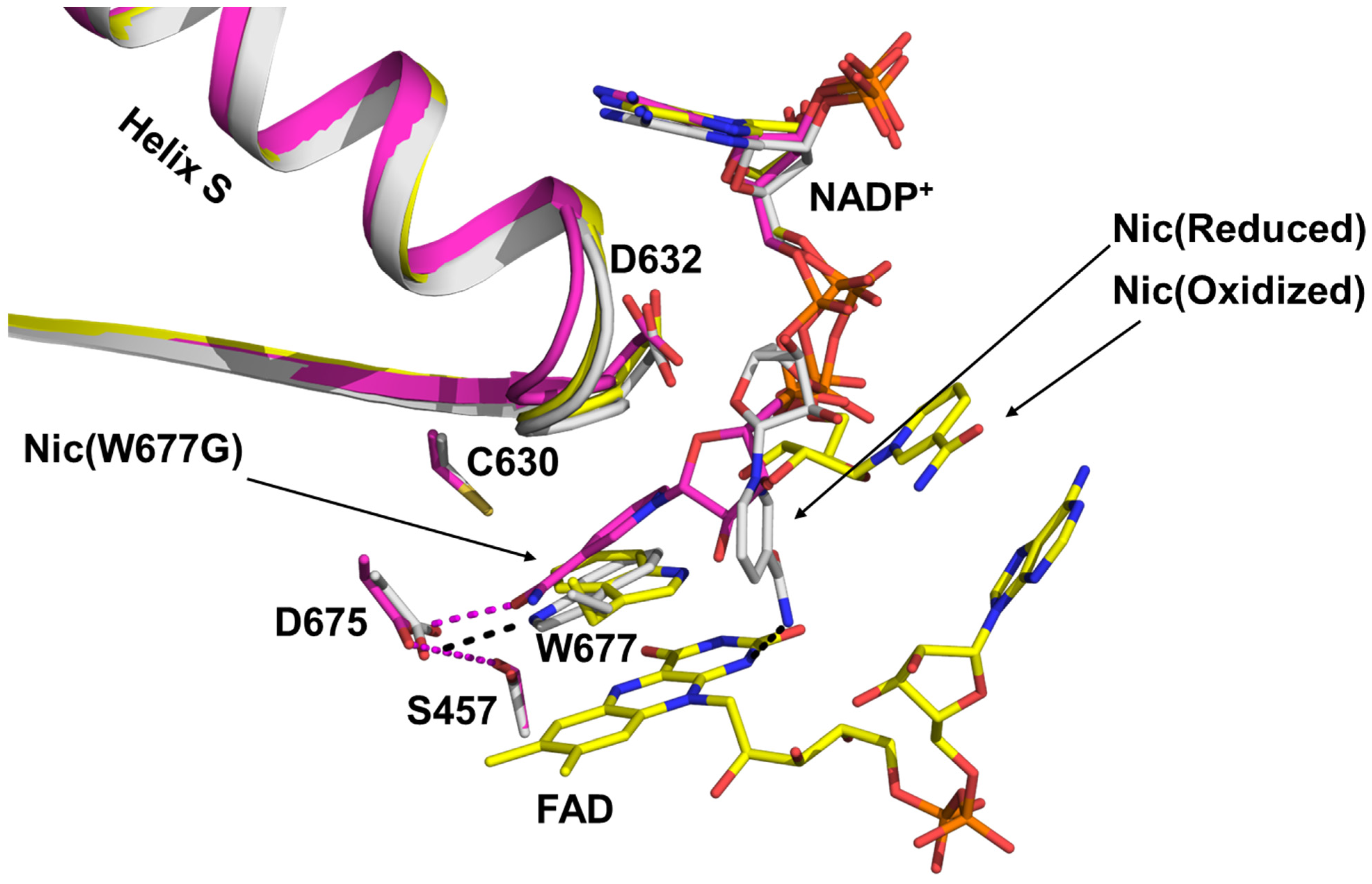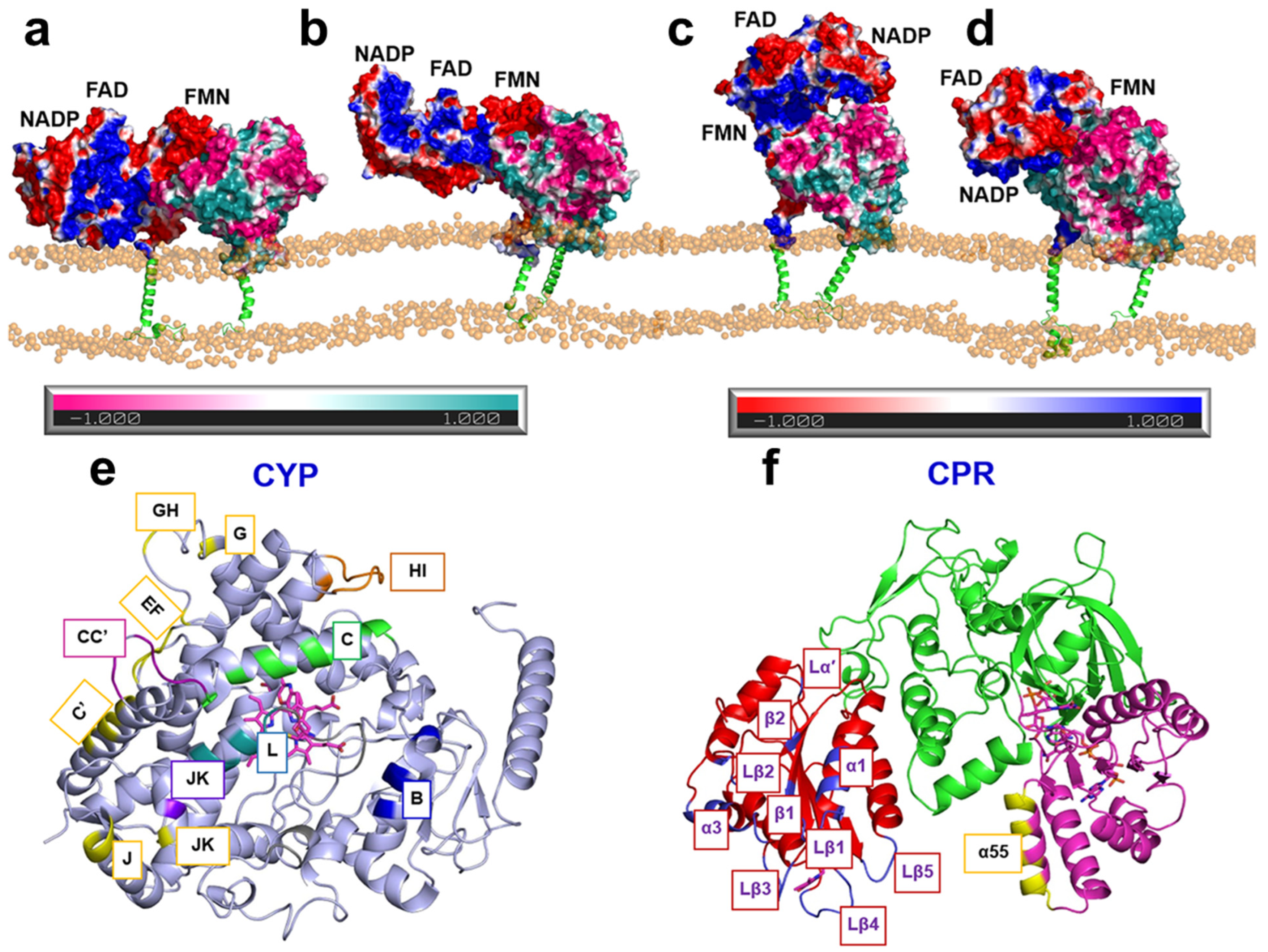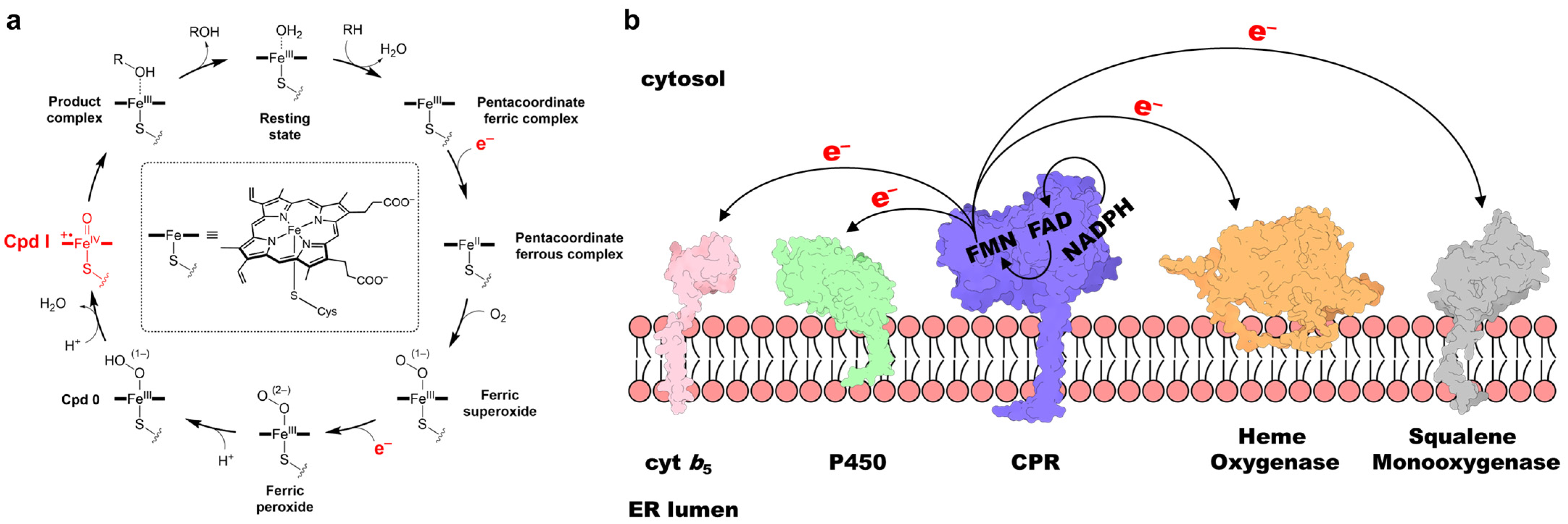Recent Advances in Elucidating the Mechanism of the NADPH–Cytochrome P450 Reductase-Mediated Electron Transfer Cycle: Experimental and Computational Perspectives
Abstract
1. Introduction

2. Recent Advances in Techniques for Studying CPR ET Properties
3. Trends in Mechanistic Studies of the CPR-Mediated ET Cycle
3.1. NADPH Binding and NADP+ Dissociation


3.2. Electron Transfer Processes Within CPR
3.3. Factors Relevant to the CPR Conformational Change

3.4. Protein–Protein Interactions and Electron Transfer Pathways Between CPR and Its Redox Partners

4. Conclusions and Outlook
Author Contributions
Funding
Institutional Review Board Statement
Informed Consent Statement
Data Availability Statement
Conflicts of Interest
References
- Ortiz de Montellano, P.R. (Ed.) Cytochrome P450: Structure, Mechanism, and Biochemistry, 4th ed.; Springer: Cham, Switzerland, 2015. [Google Scholar]
- Meunier, B.; de Visser, S.P.; Shaik, S. Mechanism of Oxidation Reactions Catalyzed by Cytochrome P450 Enzymes. Chem. Rev. 2004, 104, 3947–3980. [Google Scholar] [CrossRef]
- Shaik, S.; Kumar, D.; de Visser, S.P.; Altun, A.; Thiel, W. Theoretical Perspective on the Structure and Mechanism of Cytochrome P450 Enzymes. Chem. Rev. 2005, 105, 2279–2328. [Google Scholar] [CrossRef]
- Guengerich, F.P. Cytochrome P450 and Chemical Toxicology. Chem. Res. Toxicol. 2008, 21, 70–83. [Google Scholar] [CrossRef]
- Guengerich, F.P. Human Cytochrome P450 Enzymes. In Cytochrome P450: Structure, Mechanism, and Biochemistry, 4th ed.; Ortiz de Montellano, P.R., Ed.; Springer: Cham, Switzerland, 2015; pp. 523–786. [Google Scholar]
- McLean, K.J.; Luciakova, D.; Belcher, J.; Tee, K.L.; Munro, A.W. Biological Diversity of Cytochrome P450 Redox Partner Systems. In Monooxygenase, Peroxidase and Peroxygenase Properties and Mechanisms of Cytochrome P450; Advances in Experimental Medicine and Biology; Springer: Cham, Switzerland, 2015; Volume 851, pp. 299–317. [Google Scholar]
- Waskell, L.; Kim, J.-J.P. Electron Transfer Partners of Cytochrome P450. In Cytochrome P450: Structure, Mechanism, and Biochemistry, 4th ed.; Ortiz de Montellano, P.R., Ed.; Springer: Cham, Switzerland, 2015; pp. 33–68. [Google Scholar]
- Schacter, B.A.; Nelson, E.B.; Marver, H.S.; Masters, B.S.S. Immunochemical Evidence for an Association of Heme Oxygenase with the Microsomal Electron Transport System. J. Biol. Chem. 1972, 247, 3601–3607. [Google Scholar] [CrossRef]
- Guengerich, F.P. Reduction of Cytochrome b5 by NADPH–Cytochrome P450 Reductase. Arch. Biochem. Biophys. 2005, 440, 204–211. [Google Scholar] [CrossRef]
- Ono, T.; Takahashi, K.; Odani, S.; Konno, H.; Imai, Y. Purification of Squalene Epoxidase from Rat Liver Microsomes. Biochem. Biophys. Res. Commun. 1980, 96, 522–528. [Google Scholar] [CrossRef] [PubMed]
- Rwere, F.; Xia, C.; Im, S.; Haque, M.M.; Stuehr, D.J.; Waskell, L.; Kim, J.-J.P. Mutants of Cytochrome P450 Reductase Lacking Either Gly-141 or Gly-143 Destabilize its FMN Semiquinone. J. Biol. Chem. 2016, 291, 14639–14661. [Google Scholar] [CrossRef] [PubMed]
- FDA Approves First Treatment for Certain Types of Poor-Prognosis Acute Myeloid Leukemia. Available online: https://www.fda.gov/news-events/press-announcements/fda-approves-first-treatment-certain-types-poor-prognosis-acute-myeloid-leukemia (accessed on 6 June 2023).
- New Drug Therapy Approvals. 2020. Available online: https://web.archive.org/web/20240517161353/https://www.fda.gov/drugs/novel-drug-approvals-fda/new-drug-therapy-approvals-2020 (accessed on 9 September 2025).
- Zou, Y.; Li, H.; Graham, E.T.; Deik, A.A.; Eaton, J.K.; Wang, W.; Sandoval-Gomez, G.; Clish, C.B.; Doench, J.G.; Schreiber, S.L. Cytochrome P450 Oxidoreductase Contributes to Phospholipid Peroxidation in Ferroptosis. Nat. Chem. Biol. 2020, 16, 302–309. [Google Scholar] [CrossRef] [PubMed]
- Yan, B.; Ai, Y.; Sun, Q.; Ma, Y.; Cao, Y.; Wang, J.; Zhang, Z.; Wang, X. Membrane Damage during Ferroptosis Is Caused by Oxidation of Phospholipids Catalyzed by the Oxidoreductases POR and CYB5R1. Mol. Cell 2021, 81, 355–369.e10. [Google Scholar] [CrossRef]
- Horecker, B.; Heppel, L.A. The Reduction of Cytochrome c by Xanthine Oxidase. J. Biol. Chem. 1949, 178, 683–690. [Google Scholar] [CrossRef]
- Horecker, B. Triphosphopyridine Nucleotidecytochrome c Reductase in Liver. J. Biol. Chem. 1950, 183, 593–605. [Google Scholar] [CrossRef]
- Riddick, D.S.; Ding, X.; Wolf, C.R.; Porter, T.D.; Pandey, A.V.; Zhang, Q.-Y.; Gu, J.; Finn, R.D.; Ronseaux, S.; McLaughlin, L.A.; et al. NADPH–Cytochrome P450 Oxidoreductase: Roles in Physiology, Pharmacology, and Toxicology. Drug Metab. Dispos. 2012, 41, 12–23. [Google Scholar] [CrossRef]
- Pandey, A.V.; Flück, C.E. NADPH P450 Oxidoreductase: Structure, Function, and Pathology of Diseases. Pharmacol. Ther. 2013, 138, 229–254. [Google Scholar] [CrossRef] [PubMed]
- Iyanagi, T. Molecular Mechanism of Metabolic NAD(P)H-Dependent Electron-Transfer Systems: The Role of Redox Cofactors. Biochim. Biophys. Acta Bioenerg. 2019, 1860, 233–258. [Google Scholar] [CrossRef] [PubMed]
- Xia, C.; Rwere, F.; Im, S.; Shen, A.L.; Waskell, L.; Kim, J.-J.P. Structural and Kinetic Studies of Asp632 Mutants and Fully Reduced NADPH-Cytochrome P450 Oxidoreductase Define the Role of Asp632 Loop Dynamics in the Control of NADPH Binding and Hydride Transfer. Biochemistry 2018, 57, 945–962. [Google Scholar] [CrossRef] [PubMed]
- Wang, M.; Roberts, D.L.; Paschke, R.; Shea, T.M.; Masters, B.S.S.; Kim, J.-J.P. Three-dimensional Structure of NADPH–cytochrome P450 Reductase: Prototype for FMN- and FAD-containing Enzymes. Proc. Natl. Acad. Sci. USA 1997, 94, 8411–8416. [Google Scholar] [CrossRef]
- Sündermann, A.; Oostenbrink, C. Molecular Dynamics Simulations Give Insight into the Conformational Change, Complex Formation, and Electron Transfer Pathway for Cytochrome P450 Reductase. Protein Sci. 2013, 22, 1183–1195. [Google Scholar] [CrossRef]
- Pudney, C.R.; Khara, B.; Johannissen, L.O.; Scrutton, N.S. Coupled Motions Direct Electrons along Human Microsomal P450 Chains. PLoS Biol. 2011, 9, e1001222. [Google Scholar] [CrossRef]
- Huang, W.-C.; Ellis, J.; Moody, P.C.; Raven, E.L.; Roberts, G.C. Redox-linked Domain Movements in the Catalytic Cycle of Cytochrome P450 Reductase. Structure 2013, 21, 1581–1589. [Google Scholar] [CrossRef]
- Xia, C.; Hamdane, D.; Shen, A.L.; Choi, V.; Kasper, C.B.; Pearl, N.M.; Zhang, H.; Im, S.-C.; Waskell, L.; Kim, J.-J.P. Conformational Changes of NADPH–Cytochrome P450 Oxidoreductase are Essential for Catalysis and Cofactor Binding. J. Biol. Chem. 2011, 286, 16246–16260. [Google Scholar] [CrossRef]
- Ellis, J.; Gutierrez, A.; Barsukov, I.L.; Huang, W.-C.; Grossmann, J.G.; Roberts, G.C.K. Domain Motion in Cytochrome P450 Reductase. J. Biol. Chem. 2009, 284, 36628–36637. [Google Scholar] [CrossRef]
- Hay, S.; Brenner, S.; Khara, B.; Quinn, A.M.; Rigby, S.E.J.; Scrutton, N.S. Nature of the Energy Landscape for Gated Electron Transfer in a Dynamic Redox Protein. J. Am. Chem. Soc. 2010, 132, 9738–9745. [Google Scholar] [CrossRef] [PubMed]
- Hedison, T.M.; Hay, S.; Scrutton, N.S. Real-time Analysis of Conformational Control in Electron Transfer Reactions of Human Cytochrome P450 Reductase with Cytochrome c. FEBS Lett. J. 2015, 282, 4357–4375. [Google Scholar] [CrossRef] [PubMed]
- Leferink, N.G.; Pudney, C.R.; Brenner, S.; Heyes, D.J.; Eady, R.R.; Samar Hasnain, S.; Hay, S.; Rigby, S.E.; Scrutton, N.S. Gating Mechanisms for Biological Electron Transfer: Integrating Structure with Biophysics Reveals the Nature of Redox Control in Cytochrome P450 Reductase and Copper-Dependent Nitrite Reductase. FEBS Lett. 2012, 586, 578–584. [Google Scholar] [CrossRef] [PubMed]
- Li, N.; Yan, S.; Wu, P.; Li, J.; Wang, B. Local Electric Fields Drives the Proton-Coupled Electron Transfer within Cytochrome P450 Reductase. ACS Catal. 2024, 14, 7893–7900. [Google Scholar] [CrossRef]
- Brignac-Huber, L.; Reed, J.R.; Backes, W.L. Organization of NADPH-Cytochrome P450 Reductase and CYP1A2 in the Endoplasmic Reticulum Microdomain Localization Affects Monooxygenase Function. Mol. Pharmacol. 2011, 79, 549–557. [Google Scholar] [CrossRef]
- Das, A.; Sligar, S.G. Modulation of the Cytochrome P450 Reductase Redox Potential by the Phospholipid Bilayer. Biochemistry 2009, 48, 12104–12112. [Google Scholar] [CrossRef]
- Niu, G.; Zhao, S.; Wang, L.; Dong, W.; Liu, L.; He, Y. Structure of the Arabidopsis thaliana NADPH-Cytochrome P450 Reductase 2 (ATR2) Provides Insight into its Function. FEBS J. 2017, 284, 754–765. [Google Scholar] [CrossRef]
- Ebrecht, A.C.; van der Bergh, N.; Harrison, S.T.L.; Smit, M.S.; Sewell, B.T.; Opperman, D.J. Biochemical and Structural Insights into the Cytochrome P450 Reductase from Candida tropicalis. Sci. Rep. 2019, 9, 20088. [Google Scholar] [CrossRef]
- Hubbard, P.A.; Shen, A.L.; Paschke, R.; Kasper, C.B.; Kim, J.-J.P. NADPH–Cytochrome P450 Oxidoreductase: Structural Basis for Hydride and Electron Transfer. J. Biol. Chem. 2001, 276, 29163–29170. [Google Scholar] [CrossRef]
- Hamdane, D.; Xia, C.; Im, S.-C.; Zhang, H.; Kim, J.-J.P.; Waskell, L. Structure and Function of an NADPH-Cytochrome P450 Oxidoreductase in an Open Conformation Capable of Reducing Cytochrome P450. J. Biol. Chem. 2009, 284, 11374–11384. [Google Scholar] [CrossRef] [PubMed]
- Xia, C.; Panda, S.P.; Marohnic, C.C.; Martásek, P.; Masters, B.S.; Kim, J.-J.P. Structural basis for human NADPH-cytochrome P450 oxidoreductase deficiency. Proc. Natl. Acad. Sci. USA 2011, 108, 13486–13491. [Google Scholar] [CrossRef] [PubMed]
- Sugishima, M.; Sato, H.; Higashimoto, Y.; Harada, J.; Wada, K.; Fukuyama, K.; Noguchi, M. Structural Basis for the Electron Transfer From an Open Form of NADPH–Cytochrome P450 Oxidoreductase to Heme Oxygenase. Proc. Natl. Acad. Sci. USA 2014, 111, 2524–2529. [Google Scholar] [CrossRef] [PubMed]
- Zhang, M.; Huang, R.; Ackermann, R.; Im, S.-C.; Waskell, L.; Schwendeman, A.; Ramamoorthy, A. Reconstitution of the Cytb5–CytP450 Complex in Nanodiscs for Structural Studies using NMR Spectroscopy. Angew. Chem. Int. Ed. 2016, 55, 4497–4499. [Google Scholar] [CrossRef]
- Zhang, M.; Huang, R.; Im, S.-C.; Waskell, L.; Ramamoorthy, A. Effects of Membrane Mimetics on Cytochrome P450-Cytochrome b5 Interactions Characterized by NMR Spectroscopy. J. Biol. Chem. 2015, 290, 12705–12718. [Google Scholar] [CrossRef]
- Iyanagi, T.; Mason, H.S. Properties of Hepatic Reduced Nicotinamide Adenine Dinucleotide Phosphate–Cytochrome c Reductase. Biochemistry 1973, 12, 2297–2308. [Google Scholar] [CrossRef]
- Iyanagi, T.; Makino, R.; Anan, F.K. Studies on the Microsomal Mixed-Function Oxidase System: Mechanism of Action of Hepatic NADPH–Cytochrome P-450 Reductase. Biochemistry 1981, 20, 1722–1730. [Google Scholar] [CrossRef]
- Iyanagi, T.; Xia, C.; Kim, J.-J.P. NADPH–Cytochrome P450 Oxidoreductase: Prototypic Member of the Diflavin Reductase Family. Arch. Biochem. Biophys. 2012, 528, 72–89. [Google Scholar] [CrossRef]
- Ravula, T.; Ramamoorthy, A. Synthesis, Characterization, and Nanodisc Formation of Non-Ionic Polymers. Angew. Chem. Int. Ed. 2021, 60, 16885–16888. [Google Scholar] [CrossRef]
- Krishnarjuna, B.; Ravula, T.; Ramamoorthy, A. Detergent-Free Isolation of CYP450-Reductase’s FMN-Binding Domain in E. coli Lipid-Nanodiscs Using a Charge-Free Polymer. Chem. Commun. 2022, 58, 4913–4916. [Google Scholar] [CrossRef]
- Krishnarjuna, B.; Im, S.-C.; Ravula, T.; Marte, J.; Auchus, R.J.; Ramamoorthy, A. Non-Ionic Inulin-Based Polymer Nanodiscs Enable Functional Reconstitution of a Redox Complex Composed of Oppositely Charged CYP450 and CPR in a Lipid Bilayer Membrane. Anal. Chem. 2022, 94, 11908–11915. [Google Scholar] [CrossRef]
- Lerner, E.; Cordes, T.; Ingargiola, A.; Alhadid, Y.; Chung, S.; Michalet, X.; Weiss, S. Toward Dynamic Structural Biology: Two Decades of Single-Molecule Förster Resonance Energy Transfer. Science 2018, 359, eaan1133. [Google Scholar] [CrossRef]
- Torricella, F.; Pierro, A.; Mileo, E.; Belle, V.; Bonucci, A. Nitroxide Spin Labels and EPR Spectroscopy: A Powerful Association for Protein Dynamics Studies. Biochim. Biophys. Acta Proteins Proteom. 2021, 1869, 140653. [Google Scholar] [CrossRef] [PubMed]
- Klug, C.S.; Feix, J.B. Methods and Applications of Site-Directed Spin Labeling EPR Spectroscopy. Methods Cell Biol. 2008, 84, 617–658. [Google Scholar] [PubMed]
- Quast, R.B.; Fatemi, F.; Kranendonk, M.; Margeat, E.; Truan, G. Accurate Determination of Human CPR Conformational Equilibrium by smFRET Using Dual Orthogonal Noncanonical Amino Acid Labeling. ChemBioChem 2019, 20, 659–666. [Google Scholar] [CrossRef] [PubMed]
- Pannier, M.; Veit, S.; Godt, A.; Jeschke, G.; Spiess, H.W. Dead-Time Free Measurement of Dipole–Dipole Interactions between Electron Spins. J. Magn. Reson. 2000, 142, 331–340. [Google Scholar] [CrossRef]
- Bizet, M.; Byrne, D.; Biaso, F.; Gerbaud, G.; Etienne, E.; Briola, G.; Guigliarelli, B.; Urban, P.; Dorlet, P.; Kalai, T.; et al. Structural Insights into the Semiquinone Form of Human Cytochrome P450 Reductase by DEER Distance Measurements Between a Native Flavin and a Spin Labelled Non-Canonical Amino Acid. Chem. Eur. J. 2024, 30, e202304307. [Google Scholar] [CrossRef]
- Bizet, M.; Balázsi, Á.; Biaso, F.; Byrne, D.; Etienne, E.; Guigliarelli, B.; Urban, P.; Dorlet, P.; Truan, G.; Gerbaud, G.; et al. Expanding the Diversity of Nitroxide-Based Paramagnetic Probes Conjugated to Non-Canonical Amino Acids for Sdsl-Epr Applications. ChemBioChem 2025, 26, e202500064. [Google Scholar] [CrossRef]
- Karplus, M.; McCammon, J.A. Molecular Dynamics Simulations of Biomolecules. Nat. Struct. Biol. 2002, 9, 646–652. [Google Scholar] [CrossRef]
- Qian, R.; Xue, J.; Xu, Y.; Huang, J. Alchemical Transformations and Beyond: Recent Advances and Real-World Applications of Free Energy Calculations in Drug Discovery. J. Chem. Inf. Model. 2024, 64, 7214–7237. [Google Scholar] [CrossRef]
- Ayaz, P.; Lyczek, A.; Paung, Y.; Mingione, V.R.; Iacob, R.E.; de Waal, P.W.; Engen, J.R.; Seeliger, M.A.; Shan, Y.; Shaw, D.E. Structural Mechanism of a Drug-Binding Process Involving a Large Conformational Change of the Protein Target. Nat. Commun. 2023, 14, 1885. [Google Scholar] [CrossRef] [PubMed]
- Ahalawat, N.; Mondal, J. Mapping the Substrate Recognition Pathway in Cytochrome P450. J. Am. Chem. Soc. 2018, 140, 17743–17752. [Google Scholar] [CrossRef] [PubMed]
- Haloi, N.; Eriksson Lidbrink, S.; Howard, R.J.; Lindahl, E. Adaptive Sampling–Based Structural Prediction Reveals Opening of a GABAA Receptor through the αβ Interface. Sci. Adv. 2025, 11, eadq3788. [Google Scholar] [CrossRef] [PubMed]
- Zhuang, Y.; Howard, R.J.; Lindahl, E. Symmetry-Adapted Markov State Models of Closing, Opening, and Desensitizing in α 7 Nicotinic Acetylcholine Receptors. Nat. Commun. 2024, 15, 9022. [Google Scholar] [CrossRef]
- Kobayashi, C.; Matsunaga, Y.; Jung, J.; Sugita, Y. Structural and Energetic Analysis of Metastable Intermediate States in the E1P–E2P Transition of Ca2+-ATPase. Proc. Natl. Acad. Sci. USA 2021, 118, e2105507118. [Google Scholar] [CrossRef]
- Mafi, A.; Kim, S.-K.; Goddard, W.A. The Dynamics of Agonist-β2-Adrenergic Receptor Activation Induced by Binding of GDP-Bound Gs Protein. Nat. Chem. 2023, 15, 1127–1137. [Google Scholar] [CrossRef]
- Yan, J.; Chen, L.; Warshel, A.; Bai, C. Exploring the Activation Process of the Glycine Receptor. J. Am. Chem. Soc. 2024, 146, 26297–26312. [Google Scholar] [CrossRef]
- Liu, J.; Zhu, L. PlmCas12e Utilizes Glu662 to Prevent Cleavage Site Occupation by Positively Charged Residues Before Target Strand Cleavage. Molecules 2024, 29, 5036. [Google Scholar] [CrossRef]
- Senn, H.M.; Thiel, W. QM/MM Methods for Biomolecular Systems. Angew. Chem. Int. Ed. 2009, 48, 1198–1229. [Google Scholar] [CrossRef]
- Lonsdale, R.; Houghton, K.T.; Żurek, J.; Bathelt, C.M.; Foloppe, N.; de Groot, M.J.; Harvey, J.N.; Mulholland, A.J. Quantum Mechanics/Molecular Mechanics Modeling of Regioselectivity of Drug Metabolism in Cytochrome P450 2C9. J. Am. Chem. Soc. 2013, 135, 8001–8015. [Google Scholar] [CrossRef]
- Shaik, S.; Cohen, S.; Wang, Y.; Chen, H.; Kumar, D.; Thiel, W. P450 Enzymes: Their Structure, Reactivity, and Selectivity—Modeled by QM/MM Calculations. Chem. Rev. 2010, 110, 949–1017. [Google Scholar] [CrossRef]
- Hirao, H.; Yue, D.; Xia, S.; Zhang, E.; Zhang, H.; Yan, J.; Xiao, Z. Computational Studies on Human Cytochrome P450: Advancing Insights into Drug Metabolism. Trends Chem. 2025, 7, 358–371. [Google Scholar] [CrossRef]
- Kim, H.; Saura, P.; Pöverlein, M.C.; Gamiz-Hernandez, A.P.; Kaila, V.R.I. Quinone Catalysis Modulates Proton Transfer Reactions in the Membrane Domain of Respiratory Complex I. J. Am. Chem. Soc. 2023, 145, 17075–17086. [Google Scholar] [CrossRef] [PubMed]
- Kaila, V.R.I. Resolving Chemical Dynamics in Biological Energy Conversion: Long-Range Proton-Coupled Electron Transfer in Respiratory Complex I. Acc. Chem. Res. 2021, 54, 4462–4473. [Google Scholar] [CrossRef] [PubMed]
- Wilson, K.A.; Fernandes, P.A.; Ramos, M.J.; Wetmore, S.D. Exploring the Identity of the General Base for a DNA Polymerase Catalyzed Reaction Using QM/MM: The Case Study of Human Translesion Synthesis Polymerase η. ACS Catal. 2019, 9, 2543–2551. [Google Scholar] [CrossRef]
- Banáš, P.; Jurečka, P.; Walter, N.G.; Šponer, J.; Otyepka, M. Theoretical Studies of RNA Catalysis: Hybrid QM/MM Methods and their Comparison with MD and QM. Methods 2009, 49, 202–216. [Google Scholar] [CrossRef][Green Version]
- Hensen, C.; Hermann, J.C.; Nam, K.; Ma, S.; Gao, J.; Höltje, H.-D. A Combined QM/MM Approach to Protein–Ligand Interactions: Polarization Effects of the HIV-1 Protease on Selected High Affinity Inhibitors. J. Med. Chem. 2004, 47, 6673–6680. [Google Scholar] [CrossRef]
- Ribeiro, A.J.M.; Santos-Martins, D.; Russo, N.; Ramos, M.J.; Fernandes, P.A. Enzymatic Flexibility and Reaction Rate: A QM/MM Study of HIV-1 Protease. ACS Catal. 2015, 5, 5617–5626. [Google Scholar] [CrossRef]
- Noji, T.; Saito, K.; Ishikita, H. Absence of a Link Between Stabilized Charge-Separated State and Structural Changes Proposed from Crystal Structures of a Photosynthetic Reaction Center. Commun. Chem. 2024, 7, 192. [Google Scholar] [CrossRef]
- Sugo, Y.; Saito, K.; Ishikita, H. Mechanism of the Formation of Proton Transfer Pathways in Photosynthetic Reaction Centers. Proc. Natl. Acad. Sci. USA 2021, 118, e2103203118. [Google Scholar] [CrossRef]
- Freeman, S.L.; Martel, A.; Raven, E.L.; Roberts, G.C.K. Orchestrated Domain Movement in Catalysis by Cytochrome P450 Reductase. Sci. Rep. 2017, 7, 9741. [Google Scholar] [CrossRef] [PubMed]
- Vincent, B.; Morellet, N.; Fatemi, F.; Aigrain, L.; Truan, G.; Guittet, E.; Lescop, E. The Closed and Compact Domain Organization of the 70-kDa Human Cytochrome P450 Reductase in its Oxidized State as Revealed by NMR. J. Mol. Biol. 2012, 420, 296–309. [Google Scholar] [CrossRef] [PubMed]
- Zhang, B.; Kang, C.; Davydov, D.R. Conformational Rearrangements in the Redox Cycling of NADPH–Cytochrome P450 Reductase from Sorghum bicolor Explored with FRET and Pressure-Perturbation Spectroscopy. Biology 2022, 11, 510. [Google Scholar] [CrossRef] [PubMed]
- Murataliev, M.B.; Klein, M.; Fulco, A.; Feyereisen, R. Functional Interactions in Cytochrome P450BM3: Flavin Semiquinone Intermediates, Role of NADP(H), and Mechanism of Electron Transfer by the Flavoprotein Domain. Biochemistry 1997, 36, 8401–8412. [Google Scholar] [CrossRef]
- Murataliev, M.B.; Feyereisen, R.; Walker, F.A. Electron Transfer by Diflavin Reductases. Biochim. Biophys. Acta-Proteins Proteom. 2004, 1698, 1–26. [Google Scholar] [CrossRef]
- Grunau, A.; Paine, M.J.; Ladbury, J.E.; Gutierrez, A. Global Effects of the Energetics of Coenzyme Binding: NADPH Controls the Protein Interaction Properties of Human Cytochrome P450 Reductase. Biochemistry 2006, 45, 1421–1434. [Google Scholar] [CrossRef]
- Hubbard, P.A.; Xia, C.; Shen, A.L.; Kim, J.-J.P. Structural and Kinetic Investigations of the Carboxy Terminus of NADPH–Cytochrome P450 Oxidoreductase. Arch. Biochem. Biophys. 2021, 701, 108792. [Google Scholar] [CrossRef]
- Xia, S.; Hirao, H. The Dissociation Process of NADP+ from NADPH–Cytochrome P450 Reductase Studied by Molecular Dynamics Simulation. J. Phys. Chem. B 2024, 128, 7148–7159. [Google Scholar] [CrossRef]
- Shen, A.L.; Sem, D.S.; Kasper, C.B. Mechanistic Studies on the Reductive Half-Reaction of NADPH-Cytochrome P450 Oxidoreductase. J. Biol. Chem. 1999, 274, 5391–5398. [Google Scholar] [CrossRef]
- Campelo, D.; Esteves, F.; Brito Palma, B.; Costa Gomes, B.; Rueff, J.; Lautier, T.; Urban, P.; Truan, G.; Kranendonk, M. Probing the Role of the Hinge Segment of Cytochrome P450 Oxidoreductase in the Interaction with Cytochrome P450. Int. J. Mol. Sci. 2018, 19, 3914. [Google Scholar] [CrossRef]
- Freeman, S.L.; Martel, A.; Devos, J.M.; Basran, J.; Raven, E.L.; Roberts, G.C.K. Solution Structure of the Cytochrome P450 Reductase–Cytochrome c Complex Determined by Neutron Scattering. J. Biol. Chem. 2018, 293, 5210–5219. [Google Scholar] [CrossRef] [PubMed]
- Kovrigina, E.A.; Pattengale, B.; Xia, C.; Galiakhmetov, A.R.; Huang, J.; Kim, J.-J.P.; Kovrigin, E.L. Conformational States of Cytochrome P450 Oxidoreductase Evaluated by Förster Resonance Energy Transfer Using Ultrafast Transient Absorption Spectroscopy. Biochemistry 2016, 55, 5973–5976. [Google Scholar] [CrossRef] [PubMed]
- Gutierrez, A.; Munro, A.W.; Grunau, A.; Wolf, C.R.; Scrutton, N.S.; Roberts, G.C.K. Interflavin Electron Transfer in Human Cytochrome P450 Reductase is Enhanced by Coenzyme Binding. Relaxation Kinetic Studies with Coenzyme Analogues. Eur. J. Biochem. 2003, 270, 2612–2621. [Google Scholar] [CrossRef] [PubMed]
- Hedison, T.M.; Scrutton, N.S. Tripping the Light Fantastic in Membrane Redox Biology: Linking Dynamic Structures to Function in ER Electron Transfer Chains. FEBS J. 2019, 286, 2004–2017. [Google Scholar] [CrossRef]
- Reed, J.R.; Backes, W.L. Formation of P450·P450 Complexes and Their Effect on P450 Function. Pharmacol. Ther. 2012, 133, 299–310. [Google Scholar] [CrossRef]
- Sellner, M.; Fischer, A.; Don, C.G.; Smieško, M. Conformational Landscape of Cytochrome P450 Reductase Interactions. Int. J. Mol. Sci. 2021, 22, 1023. [Google Scholar] [CrossRef]
- Mukherjee, G.; Nandekar, P.P.; Wade, R.C. An Electron Transfer Competent Structural Ensemble of Membrane-bound Cytochrome P450 1A1 and Cytochrome P450 Oxidoreductase. Commun. Biol. 2021, 4, 55. [Google Scholar] [CrossRef]
- Manzoor, S.; Hofer, T.S.; Moin, S.T. Revealing New Insights into the Dynamics of Human Aromatase Interacting with Cytochrome P450 Reductase in a Realistic Membrane Environment. J. Chem. Inf. Model. 2025, 65, 4602–4619. [Google Scholar] [CrossRef]
- Iijima, M.; Ohnuki, J.; Sato, T.; Sugishima, M.; Takano, M. Coupling of Redox and Structural States in Cytochrome P450 Reductase Studied by Molecular Dynamics Simulation. Sci. Rep. 2019, 9, 9341. [Google Scholar] [CrossRef]
- Xia, C.; Shen, A.L.; Duangkaew, P.; Kotewong, R.; Rongnoparut, P.; Feix, J.; Kim, J.-J.P. Structural and Functional Studies of the Membrane-Binding Domain of NADPH–Cytochrome P450 Oxidoreductase. Biochemistry 2019, 58, 2408–2418. [Google Scholar] [CrossRef]
- Rwere, F.; Cartee, N.M.P.; Yang, Y.; Waskell, L. A Flexible Linker of 8-Amino Acids Between the Membrane Binding Segment and the FMN Domain of Cytochrome P450 Reductase is Necessary for Optimal Activity. J. Inorg. Biochem. 2024, 259, 112667. [Google Scholar] [CrossRef]
- Esteves, F.; Almeida, C.M.M.; Silva, S.; Saldanha, I.; Urban, P.; Rueff, J.; Pompon, D.; Truan, G.; Kranendonk, M. Single Mutations in Cytochrome P450 Oxidoreductase Can Alter the Specificity of Human Cytochrome P450 1A2-Mediated Caffeine Metabolism. Biomolecules 2023, 13, 1083. [Google Scholar] [CrossRef] [PubMed]
- Esteves, F.; Campelo, D.; Gomes, B.C.; Urban, P.; Bozonnet, S.; Lautier, T.; Rueff, J.; Truan, G.; Kranendonk, M. The Role of the FMN-Domain of Human Cytochrome P450 Oxidoreductase in Its Promiscuous Interactions with Structurally Diverse Redox Partners. Front. Pharmacol. 2020, 11, 299. [Google Scholar] [PubMed]
- Lewis, B.C.; Mackenzie, P.I.; Miners, J.O. Application of Homology Modeling to Generate CYP1A1 Mutants with Enhanced Activation of the Cancer Chemotherapeutic Prodrug Dacarbazine. Mol. Pharmacol. 2011, 80, 879–888. [Google Scholar] [CrossRef] [PubMed]
- Fishelovitch, D.; Hazan, C.; Hirao, H.; Wolfson, H.J.; Nussinov, R.; Shaik, S. QM/MM Study of the Active Species of the Human Cytochrome P450 3A4, and the Influence thereof of the Multiple Substrate Binding. J. Phys. Chem. B 2007, 111, 13822–13832. [Google Scholar] [CrossRef]
- Ritacco, I.; Spinello, A.; Ippoliti, E.; Magistrato, A. Post-Translational Regulation of CYP450s Metabolism as Revealed by All-Atoms Simulations of the Aromatase Enzyme. J. Chem. Inf. Model. 2019, 59, 2930–2940. [Google Scholar] [CrossRef]
- Fernández-Cancio, M.; Camats, N.; Flück, C.E.; Zalewski, A.; Dick, B.; Frey, B.M.; Monné, R.; Torán, N.; Audí, L.; Pandey, A.V. Mechanism of the Dual Activities of Human CYP17A1 and Binding to Anti-Prostate Cancer Drug Abiraterone Revealed by a Novel V366M Mutation Causing 17,20 Lyase Deficiency. Pharmaceuticals 2018, 11, 37. [Google Scholar] [CrossRef]
- Desai, A.J.; Miller, L.J. Changes in the Plasma Membrane in Metabolic Disease: Impact of the Membrane Environment on G protein-Coupled Receptor Structure and Function. Br. J. Pharmacol. 2018, 175, 4009–4025. [Google Scholar] [CrossRef]
- Corradi, V.; Sejdiu, B.I.; Mesa-Galloso, H.; Abdizadeh, H.; Noskov, S.Y.; Marrink, S.J.; Tieleman, D.P. Emerging Diversity in Lipid–Protein Interactions. Chem. Rev. 2019, 119, 5775–5848. [Google Scholar] [CrossRef]
- Levental, I.; Lyman, E. Regulation of Membrane Protein Structure and Function by Their Lipid Nano-Environment. Nat. Rev. Mol. Cell Biol. 2023, 24, 107–122. [Google Scholar] [CrossRef]
- Piper, S.J.; Johnson, R.M.; Wootten, D.; Sexton, P.M. Membranes under the Magnetic Lens: A Dive into the Diverse World of Membrane Protein Structures Using Cryo-EM. Chem. Rev. 2022, 122, 13989–14017. [Google Scholar] [CrossRef]
- Choy, B.C.; Cater, R.J.; Mancia, F.; Pryor, E.E. A 10-Year Meta-Analysis of Membrane Protein Structural Biology: Detergents, Membrane Mimetics, and Structure Determination Techniques. Biochim. Biophys. Acta-Biomembr. 2021, 1863, 183533. [Google Scholar] [CrossRef]
- Su, M.; Chakraborty, S.; Osawa, Y.; Zhang, H. Cryo-EM Reveals the Architecture of the Dimeric Cytochrome P450 CYP102A1 Enzyme and Conformational Changes Required for Redox Partner Recognition. J. Biol. Chem. 2020, 295, 1637–1645. [Google Scholar] [CrossRef]
- Abramson, J.; Adler, J.; Dunger, J.; Evans, R.; Green, T.; Pritzel, A.; Ronneberger, O.; Willmore, L.; Ballard, A.J.; Bambrick, J.; et al. Accurate Structure Prediction of Biomolecular Interactions with AlphaFold 3. Nature 2024, 630, 493–500. [Google Scholar] [CrossRef]

Disclaimer/Publisher’s Note: The statements, opinions and data contained in all publications are solely those of the individual author(s) and contributor(s) and not of MDPI and/or the editor(s). MDPI and/or the editor(s) disclaim responsibility for any injury to people or property resulting from any ideas, methods, instructions or products referred to in the content. |
© 2025 by the authors. Licensee MDPI, Basel, Switzerland. This article is an open access article distributed under the terms and conditions of the Creative Commons Attribution (CC BY) license (https://creativecommons.org/licenses/by/4.0/).
Share and Cite
Xia, S.; Hirao, H. Recent Advances in Elucidating the Mechanism of the NADPH–Cytochrome P450 Reductase-Mediated Electron Transfer Cycle: Experimental and Computational Perspectives. Molecules 2025, 30, 3733. https://doi.org/10.3390/molecules30183733
Xia S, Hirao H. Recent Advances in Elucidating the Mechanism of the NADPH–Cytochrome P450 Reductase-Mediated Electron Transfer Cycle: Experimental and Computational Perspectives. Molecules. 2025; 30(18):3733. https://doi.org/10.3390/molecules30183733
Chicago/Turabian StyleXia, Songyan, and Hajime Hirao. 2025. "Recent Advances in Elucidating the Mechanism of the NADPH–Cytochrome P450 Reductase-Mediated Electron Transfer Cycle: Experimental and Computational Perspectives" Molecules 30, no. 18: 3733. https://doi.org/10.3390/molecules30183733
APA StyleXia, S., & Hirao, H. (2025). Recent Advances in Elucidating the Mechanism of the NADPH–Cytochrome P450 Reductase-Mediated Electron Transfer Cycle: Experimental and Computational Perspectives. Molecules, 30(18), 3733. https://doi.org/10.3390/molecules30183733






